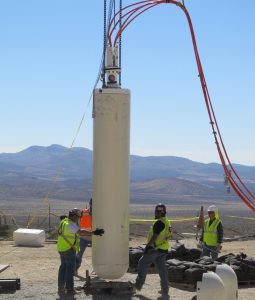5 January 2017
What was that rumble? New research compares earthquakes to explosions
Posted by Lauren Lipuma

Caption: Workers prepare to insert a canister holding explosives and diagnostic equipment for the seismic and geomorphic experiment.
Credit: National Nuclear Security Administration.
By Sarah Derouin
The earth shakes similarly after earthquakes and underground explosions, making it hard to distinguish between the two types of rumbling events. A new study aims to capture the subtle details of seismic signatures and ground deformation after an explosion to help scientists better differentiate between them.
As the global community becomes more connected with seismic instruments, one of the first signs of something like an explosion would come from seismic readings, said Emily Schultz-Fellenz, a geoscientist at Los Alamos National Laboratory, in Los Alamos, New Mexico and lead author of the new study. The new study is a first step at documenting what happens after an explosion and may be useful in differentiating between an earthquake and an explosion in the future, said Schultz-Fellenz, who presented the work at the 2016 American Geophysical Union Fall Meeting.
Schultz-Fellenz and other scientists working on the Nevada Source Physics Experiment set off controlled explosions in a granite-dominated setting to be better able to differentiate between an underground nuclear explosion and shaking due to earthquakes. The team also recorded and measured what happens to the ground surface after an explosion.
The research team divided a field site in the southern Nevada desert into a grid containing 126 survey points where seismic and ground deformation data was collected. They concentrated a higher density of survey points around the explosion site to better capture range and extent of ground deformation.
Drones were flown over the study site to collect detailed photos of the survey grid and ground surface. More than 1,600 overlapping photos were taken of the site, and using specialized software, these photos were mosaicked together creating a 3-D image of the ground surface, accurate to the nearest centimeter. This process created a detailed survey of the ground allowing the team to detect any changes elevation or sideways displacement after the explosion.
Within 48 hours after the explosion, the drone was again flown over the study area, capturing the aftermath on the ground surface.
“What our research found is that even small explosions—a few tons—in hard rock like granite have subtle but detectable surface signatures,” Schultz-Fellen said. The team found that after the explosion, 1-18 cm (0.4-7 inches) of deformation occurred, raising and lowering the land surface varying amounts, with the most deformation occurring around the explosion site. She added that this is the first published work to date that documented what happens at the surface after an underground explosion.
In addition to monitoring surface deformation, the team also collected specific details on the seismic signature of a known explosion in a specific geologic environment.
Examining surface deformation provides another tool to help reduce the ambiguities seen in seismic signals alone, according to Schultz-Fellenz. “Our photogrammetry data are one piece of that puzzle, a bit of diagnostic data if you will, showing there is a surface signature from a small explosion buried in granite,” she said.
The study is a first step in understanding what sort of deformation might occur after an explosion, but Schultz-Fellen said it is too early in the research to fully understand geologic and topographic signatures. Future work will include repeating the experiment in other geologic areas; Differences in rock type, faults and structure of an area will help scientists to better understand what controls the geology might have on the seismic magnitudes and spatial extent of detectable surface damage in an explosion.
—Sarah Derouin is a science communication graduate student at UC Santa Cruz. You can follow her on twitter at @Sarah_Derouin or on her website at sarahderouin.com.










 GeoSpace is a blog on Earth and space science, managed by AGU’s Public Information staff. The blog features posts by AGU writers and guest contributors on all sorts of relevant science topics, but with a focus on new research and geo and space sciences-related stories that are currently in the news.
GeoSpace is a blog on Earth and space science, managed by AGU’s Public Information staff. The blog features posts by AGU writers and guest contributors on all sorts of relevant science topics, but with a focus on new research and geo and space sciences-related stories that are currently in the news.